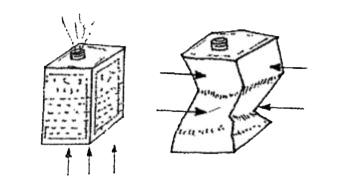When cold water is poured over a tightly corked tin can containing steam, the tin can gets crushed. What crushes the tin can?
The correct Answer is:Air pressure (or Atmospheric pressure) .
To understand why the tin can gets crushed when cold water is poured over it, we can break down the explanation into several steps:
Step 1: Initial Condition of the Tin Can
- The tin can is tightly corked and contains steam. Steam is water in its gaseous state and occupies a larger volume compared to liquid water.
Step 2: Pouring Cold Water
- When cold water is poured over the tin can, the temperature of the steam inside the can decreases rapidly.
Step 3: Condensation of Steam
- As the steam cools down, it condenses back into liquid water. This process is known as condensation.
Step 4: Volume Change
- The volume occupied by water is significantly less than that occupied by steam. Therefore, when the steam condenses into water, the overall volume inside the tin can decreases.
Step 5: Pressure Drop Inside the Can
- The decrease in volume leads to a drop in pressure inside the tin can. The pressure inside the can becomes less than the atmospheric pressure outside the can.
Step 6: Effect of Atmospheric Pressure
- The atmospheric pressure outside the can is now greater than the pressure inside the can. This difference in pressure causes the external air to exert a force on the can.
Step 7: Crushing of the Tin Can
- The greater atmospheric pressure pushes against the walls of the tin can, causing it to be crushed.
Conclusion
- The crushing of the tin can is ultimately due to the difference in pressure between the inside of the can (which is lower due to condensation) and the outside atmospheric pressure.
Final Answer
The tin can gets crushed due to atmospheric pressure.
---
- The tin can is tightly corked and contains steam. Steam is water in its gaseous state and occupies a larger volume compared to liquid water.
- When cold water is poured over the tin can, the temperature of the steam inside the can decreases rapidly.
- As the steam cools down, it condenses back into liquid water. This process is known as condensation.
- The volume occupied by water is significantly less than that occupied by steam. Therefore, when the steam condenses into water, the overall volume inside the tin can decreases.
- The decrease in volume leads to a drop in pressure inside the tin can. The pressure inside the can becomes less than the atmospheric pressure outside the can.
- The atmospheric pressure outside the can is now greater than the pressure inside the can. This difference in pressure causes the external air to exert a force on the can.
- The greater atmospheric pressure pushes against the walls of the tin can, causing it to be crushed.
- The crushing of the tin can is ultimately due to the difference in pressure between the inside of the can (which is lower due to condensation) and the outside atmospheric pressure.
The tin can gets crushed due to atmospheric pressure.
Topper's Solved these Questions
Similar Questions
Knowledge Check
Why do iron cans coated with tin are used to store food?
ATo give it a shiny textureBTo protect it from rustingCTo make it scratch-resistantDTo prevent formation of poisonous chemicalFood cans are coated with tin and not with zinc because
AZinc is costlier than tinBZinc has a higher melting point than tinCZinc is more reactive than tinDZinc is less reactive than tinWhen ice is heated, it changes to water and water on further heating gets converted to steam. What happens when steam is condensed?
AA new substance is formedBNo new substance is formedCGaseous phase changes to liquid phaseDBoth (b) and (c) are correct
A coin kept in a bowl is not visible when seen from one side. But, when water is poured in the bowl, the coin becomes visible.
View SolutionSome water in a tin with a lid which can be tightly screwed on its open mouth. The water is heated to boil and the steam from boiling water is allowed to escape for some time. The open mouth is sealed with air-tight cap and the can is cooled under tap-water. The sides of the can are crushed and get deformed.

View SolutionFood cans are coated with tin and not with zinc because
View SolutionFood cans are coated with tin and not with zinc because
View SolutionFood cans are coated with tin and not with zinc because
View Solution
